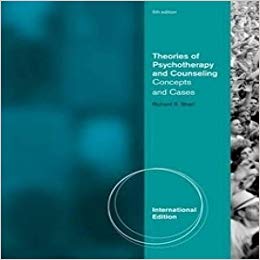Description
Theories of Psychotherapy & Counseling Concepts and Cases 5th Edition International Edition – Test Bank
EXAM QUESTIONS FOR
THEORIES OF PSYCHOTHERAPY AND COUNSELING: CONCEPTS AND CASES
FIFTH EDITON, RICHARD S. SHARF
Most of the multiple choice questions are about important concepts and their application. I have tried to vary the type of question and difficulty level. I have included a very few questions about details of cases described in the text. The numbers next to the answer indicate that it is the correct answer and show on what page of the text it can be found. A few correct answers have no specific page reference and correct answers are indicated with an *. Instructors may wish to change the order in which the questions are presented, as the order sometimes gives a clue to the correct answer. Typically, I have listed them in the order that they occur in the text. Questions comparing one theory to another will be found throughout. However, questions from Chapter 16 include only questions that compare one theory with another. Perhaps the best instructions are: Please choose the best answer from the choices that are given. Students may view practice questions on the Cengage*Brooks/Cole website for students. There are 10 questions for each chapter. None will be repeats of these questions.
Please remember to delete the page numbers when creating a test!
CHAPTER 1
INTRODUCTION
- Theories of any type should be based on
- clear rules. (2)
- many assumptions.
- a unique plan.
- unrelated laws or relationships.
- The term “counseling”
- does not differ consistently from “psychotherapy”. (4)
- is used to differentiate types of mental health professionals.
- refers to helping people with educational and vocational concerns.
- refers to helping people with normal problems.
- The term “psychotherapy”
- does not differ consistently from “counseling”. (4)
- is used to differentiate types of mental health professionals.
- refers to helping people with educational and vocational concerns.
- refers to helping people with normal problems
- The most commonly identified approach to psychotherapy is
- behavioral.
- cognitive.
- integrative. (4)
- psychoanalytic/psychodynamic.
- Which of these statements is a factor common to all therapies?
- The relationship between client and therapist is important for progress. (10)
- The therapist should be integrative.
- The therapist should be trained in psychoanalysis.
- The therapist should be able to give good advice.
- An individual who is very talkative and distractible may be exhibiting behavior best described as
- anxious.
- compulsive.
- manic. (13)
- unpredictable.
- Mary has difficulty getting up in the morning and has little desire to do her school work. This could be an indication of
- borderline personality disorder.
- depression. (13)
- generalized anxiety disorder.
- a phobia.
- Abigail has had several brief romantic relationships, all ending in disappointment as she has felt that her lovers did not live up to her expectations. This is most likely an indication of a (an)
- borderline personality disorder. (14)
- depression.
- generalized anxiety disorder.
- obsessive-compulsive disorder.

Reviews
There are no reviews yet.